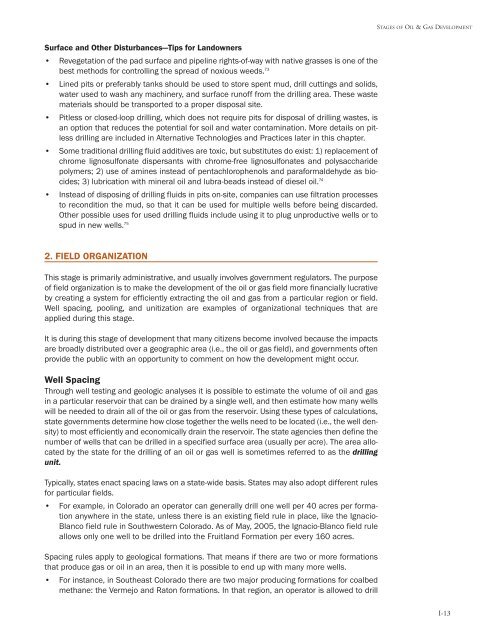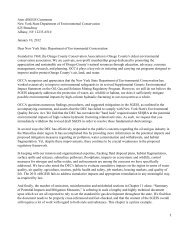Oil and Gas at Your Door? (2005 Edition) - Earthworks
Oil and Gas at Your Door? (2005 Edition) - Earthworks
Oil and Gas at Your Door? (2005 Edition) - Earthworks
Create successful ePaper yourself
Turn your PDF publications into a flip-book with our unique Google optimized e-Paper software.
STAGES OF OIL & GAS DEVELOPMENT<br />
Surface <strong>and</strong> Other Disturbances—Tips for L<strong>and</strong>owners<br />
• Reveget<strong>at</strong>ion of the pad surface <strong>and</strong> pipeline rights-of-way with n<strong>at</strong>ive grasses is one of the<br />
best methods for controlling the spread of noxious weeds. 73<br />
• Lined pits or preferably tanks should be used to store spent mud, drill cuttings <strong>and</strong> solids,<br />
w<strong>at</strong>er used to wash any machinery, <strong>and</strong> surface runoff from the drilling area. These waste<br />
m<strong>at</strong>erials should be transported to a proper disposal site.<br />
• Pitless or closed-loop drilling, which does not require pits for disposal of drilling wastes, is<br />
an option th<strong>at</strong> reduces the potential for soil <strong>and</strong> w<strong>at</strong>er contamin<strong>at</strong>ion. More details on pitless<br />
drilling are included in Altern<strong>at</strong>ive Technologies <strong>and</strong> Practices l<strong>at</strong>er in this chapter.<br />
• Some traditional drilling fluid additives are toxic, but substitutes do exist: 1) replacement of<br />
chrome lignosulfon<strong>at</strong>e dispersants with chrome-free lignosulfon<strong>at</strong>es <strong>and</strong> polysaccharide<br />
polymers; 2) use of amines instead of pentachlorophenols <strong>and</strong> paraformaldehyde as biocides;<br />
3) lubric<strong>at</strong>ion with mineral oil <strong>and</strong> lubra-beads instead of diesel oil. 74<br />
• Instead of disposing of drilling fluids in pits on-site, companies can use filtr<strong>at</strong>ion processes<br />
to recondition the mud, so th<strong>at</strong> it can be used for multiple wells before being discarded.<br />
Other possible uses for used drilling fluids include using it to plug unproductive wells or to<br />
spud in new wells. 75<br />
2. FIELD ORGANIZATION<br />
This stage is primarily administr<strong>at</strong>ive, <strong>and</strong> usually involves government regul<strong>at</strong>ors. The purpose<br />
of field organiz<strong>at</strong>ion is to make the development of the oil or gas field more financially lucr<strong>at</strong>ive<br />
by cre<strong>at</strong>ing a system for efficiently extracting the oil <strong>and</strong> gas from a particular region or field.<br />
Well spacing, pooling, <strong>and</strong> unitiz<strong>at</strong>ion are examples of organiz<strong>at</strong>ional techniques th<strong>at</strong> are<br />
applied during this stage.<br />
It is during this stage of development th<strong>at</strong> many citizens become involved because the impacts<br />
are broadly distributed over a geographic area (i.e., the oil or gas field), <strong>and</strong> governments often<br />
provide the public with an opportunity to comment on how the development might occur.<br />
Well Spacing<br />
Through well testing <strong>and</strong> geologic analyses it is possible to estim<strong>at</strong>e the volume of oil <strong>and</strong> gas<br />
in a particular reservoir th<strong>at</strong> can be drained by a single well, <strong>and</strong> then estim<strong>at</strong>e how many wells<br />
will be needed to drain all of the oil or gas from the reservoir. Using these types of calcul<strong>at</strong>ions,<br />
st<strong>at</strong>e governments determine how close together the wells need to be loc<strong>at</strong>ed (i.e., the well density)<br />
to most efficiently <strong>and</strong> economically drain the reservoir. The st<strong>at</strong>e agencies then define the<br />
number of wells th<strong>at</strong> can be drilled in a specified surface area (usually per acre). The area alloc<strong>at</strong>ed<br />
by the st<strong>at</strong>e for the drilling of an oil or gas well is sometimes referred to as the drilling<br />
unit.<br />
Typically, st<strong>at</strong>es enact spacing laws on a st<strong>at</strong>e-wide basis. St<strong>at</strong>es may also adopt different rules<br />
for particular fields.<br />
• For example, in Colorado an oper<strong>at</strong>or can generally drill one well per 40 acres per form<strong>at</strong>ion<br />
anywhere in the st<strong>at</strong>e, unless there is an existing field rule in place, like the Ignacio-<br />
Blanco field rule in Southwestern Colorado. As of May, <strong>2005</strong>, the Ignacio-Blanco field rule<br />
allows only one well to be drilled into the Fruitl<strong>and</strong> Form<strong>at</strong>ion per every 160 acres.<br />
Spacing rules apply to geological form<strong>at</strong>ions. Th<strong>at</strong> means if there are two or more form<strong>at</strong>ions<br />
th<strong>at</strong> produce gas or oil in an area, then it is possible to end up with many more wells.<br />
• For instance, in Southeast Colorado there are two major producing form<strong>at</strong>ions for coalbed<br />
methane: the Vermejo <strong>and</strong> R<strong>at</strong>on form<strong>at</strong>ions. In th<strong>at</strong> region, an oper<strong>at</strong>or is allowed to drill<br />
I-13




